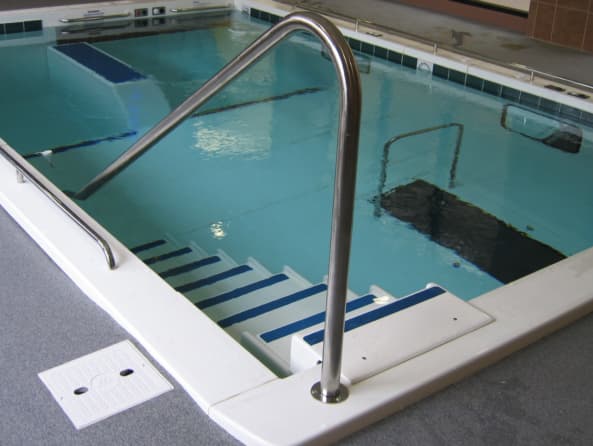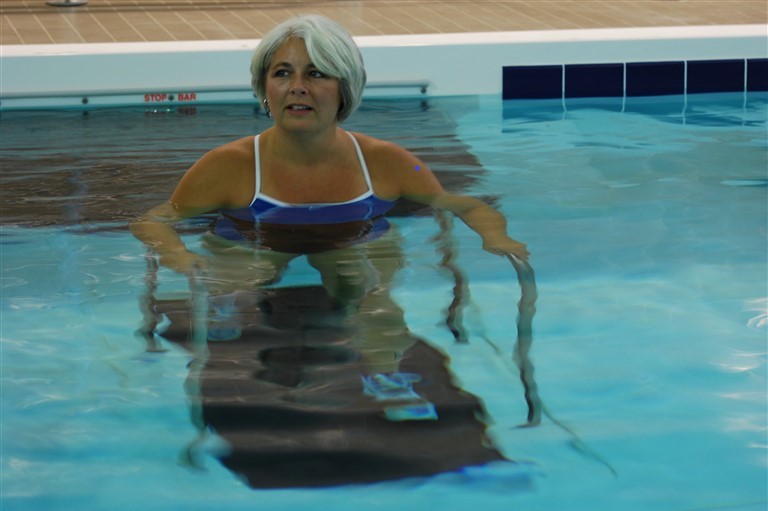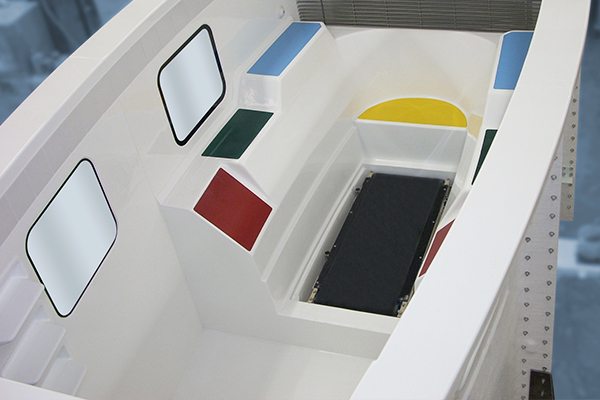The typical patient will find the aquatic environment to be desirable, beneficial, and productive. Water therapy can be performed in any pool but there are additional functionalities and basics a therapist should consider when choosing the right pool for the patient and the treatment plan.
Lifts
Public pools are required by the Americans with Disabilities Act (ADA) to have a pool lift that allow access to all patient populations. This can be either a chair, hammock, or zero entry lift. If needed, a lift can safely transition a patient into the water. It is recommended that a licensed professional oversee every patient using a pool lift. While this is not the only way a patient can enter the pool, it is the safest method to use with a more compromised patient.
Stairs/steps
All pools have stairs or steps that can serve as another way to access the pool. They are a great way for patients to practice proper mechanics bearing less weight and can be used to strengthen both lower and upper extremities depending on the depth.

Integrated treadmill
This is a great addition to the aquatic environment. Treadmills can help reeducate patients to proper gait patterns by restoring muscle memory. The treadmill can be further progressed by changing their speed, walking direction, or using it in conjunction with the water current.

Performance zones/workstations
Some hydrotherapy pools come with pre-installed, color coded work stations to easily explain and perform exercises. Built at various depths and located around the pool, these offer additional ways for patients to implement water protocols.

Water current
Most therapeutic pools have an adjustable water current that can be used as a mechanical advantage depending on the goals of the treatment session. This feature can be used to progress patients by improving neuromuscular education, proper walking mechanics, passive and active range of motion, and open and closed chain strengthening.
Jets
Similar to the jets found in a hot tub, hydrotherapy jets can be strategically placed in a pool to massage and loosen muscles.
Pool accessories
Flippers, gloves, floating dumbbells, ankle weights, kickboards, noodles, aqua joggers and other pool toys can all be used to enhance aquatic therapy. These accessories provide drag which can add resistant to further enhance an exercise or help a patient float with minimal effort.
Getting started
There are a few basics you should do before you begin.
Consider the timing
First decide the best time to introduce water therapy into the treatment plan. This can vary from therapist to therapist and patient to patient. The main question to ask is: will decreasing body weight during protocols help decrease symptoms? If the answer is yes, then water therapy is a beneficial approach.
Check the temperature
The water temperature must be between 92-95 degrees to be categorized as “therapeutic.” This water temperature has many benefits such as increased blood flow to the working muscles, decreased edema, and decreased pain. Patients can improve their range of range of motion and see an increase in functional movements. Again, it is important to review the reasons to avoid hydrotherapy. High water temperatures may adversely affect patients with cardiac and respiratory conditions. These patients should be further examined prior to getting in the pool.
Teach patients exercises before diving in
Providing patients with a comfortable home exercise program they can learn prior to entering the pool will help achieve successful results. If patients are familiar with specific exercises before getting in the pool, it’s easier to focus on improving functional movements in an essentially weightless, pain-free environment.
There are many other pool features and options available on the market. Dive in today and make water therapy part of your treatment plan.
~ Authored by Liz Lecomte
Thinking about adding a pool to your facility?
Use the FREE ROI calculator to measure the return on investment by pool type.